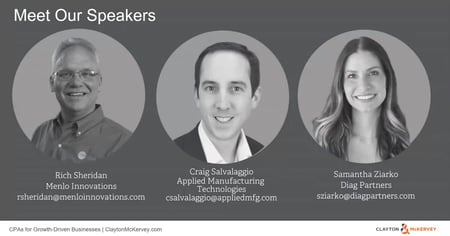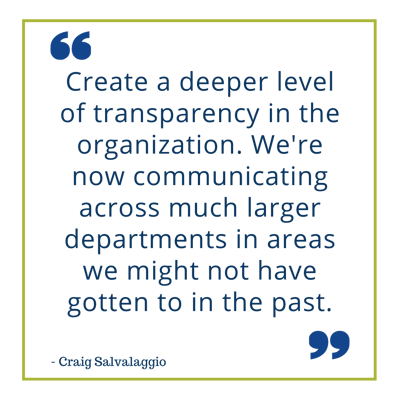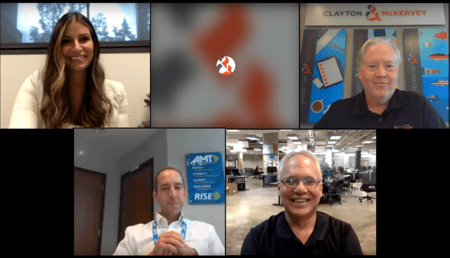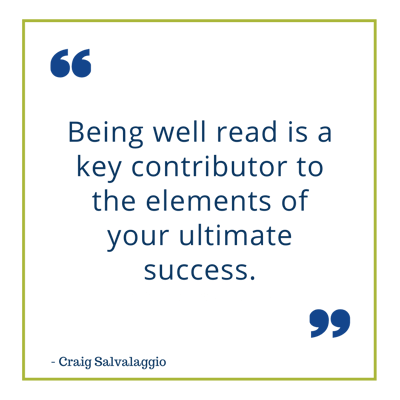Craig Salvalaggio: Recruiting & Retention Builds a Winning Team
Craig Salvalaggio participated in an hour-long roundtable discussion 'Talent 101: Build a Winning Team' hosted by Clayton & McKervey in August 2021.
Clayton & McKervey hosted a roundtable discussion focused on employee recruiting and retention in the automation industry. Together with Samantha Ziarko of Diag Partners and Rich Sheridan of Menlo Innovations, Applied Manufacturing Technology’s Chief Operating Officer Craig Salvalaggio participated in the hour-long discussion.
“I’m excited to provide a little insight from my perspective,” said Craig. “I’ve had the privilege to grow in the environment at Applied Manufacturing Technologies and really learned from the founder and CEO Mike Jacobs, who is my mentor today and over the last 18 years. I contributed early on at AMT as a technical team member and then progressed towards customer- and industry-facing advocacy for the robotics and automation space, and more strategically on the purpose that we truly serve which is to help customers successfully deploy automation and become more competitive.
How to Build a Winning Team
“My general comments on building a winning team are in three areas that I really focus on and believe in. The first area is any time you're building a team and you add a new team member, you've essentially created a new team so it's important to match the culture and the work environment to the desires of the candidate and get a good match there. The second general comment is to establish trust within the team as early as possible. In order to do this, the leader must demonstrate vulnerability in an open environment that allows them to remove the fear of conflict. If you can get these items out on the table quickly and get to consensus faster you can gain faster accountability and achieve the desired results. On the surface, it sounds easy but in  practice it's very difficult to achieve. My third general comment on building a winning team that sustains excellence over time is the ability for the leader to empower the team to act. What I mean by that is clear communication through all levels of the organization department or group and then transparency of data so that decision-making can make its way all the way down to the front line.”
practice it's very difficult to achieve. My third general comment on building a winning team that sustains excellence over time is the ability for the leader to empower the team to act. What I mean by that is clear communication through all levels of the organization department or group and then transparency of data so that decision-making can make its way all the way down to the front line.”
AMT’s Company Culture
Host Tim Finerty, Shareholder at Clayton & McKervey asked Craig to discuss three specific areas that AMT looks for during the hiring process to match candidates to the company’s culture that are applicable not only to engineers but also to senior professionals. “We'll unpack that a little bit, starting with the question of what is culture?” said Craig. “Culture is something you can feel and hear and understand when you're in the environment. You want others to be able to take that away as well.
“At AMT and in our working environment, we're looking for individuals that can operate in an area where there's a lot of new problems to solve in highly customized solutions and with a constant learning model. We look for three specific things: one is intellectual curiosity. We want those engineers, those sales professionals, those next-level managers to really want to seek next-level education for themselves; we want that hunger. The second piece is we're looking for highly intellectual individuals, in some cases engineers, in some cases trained professionals that are consulting for others, and we want that willingness to self-invest. In their off hours, they're continually looking for new ways to achieve the desired result and really investing in themselves. The third piece is, at the end of the day, what we really need is humility in all of our engineers regardless of the caliber of talent. We look for humility and humbleness because of a couple of different reasons. In building a team, you want to point out others’ contributions before your own. You want someone who's slow to seek attention for themselves and wants to contribute to the group and then wants to share that credit because we are defining success as a collective effort. I’ll use a Jim Collins reference: first who, then what. Be sure you're hiring the right individuals and then ensure that they have the right seat on the team, beyond technical competency and technical expertise.”
Retaining Culture when Working Remotely
How do companies maintain their culture amid the massive changes in the workplace due to COVID-19? Craig believes that employees need to adapt and change in times of uncertainty, which is especially true of leadership. “It goes back to the Stockdale Paradox,” said Craig. “It’s easier when you have a defined period of time that you know something's going to en d, but in this case, with COVID-19, there's no definite ending period. Historically, I’ve always judged how much work is being accomplished by the number of cars in the parking lot or how long they were here and since COVID, I have had to change as a leader. I had to change and understand that the productivity was happening outside. It's our ability to adapt but then, at the end of the day, those founding principles of the company that sustained our organization over 30-plus years, none of that changes and you have to keep that at the core. One of the biggest things that we've done and I’ve seen other companies do is just create a deeper level of transparency in the organization. Even though a department may have sat just across the hall, you may not have interacted much with them in person. Some issues around remote work have led to good change where we're now communicating across much larger departments in areas that we might not have gotten into in the past. It forced you to really adapt and run those experiments and try a couple new things and see what sticks moving forward. I think at the end of the day, we need adaptability, our own self-purpose, and to understand that maybe the leader has to adapt to new ways as well.”
d, but in this case, with COVID-19, there's no definite ending period. Historically, I’ve always judged how much work is being accomplished by the number of cars in the parking lot or how long they were here and since COVID, I have had to change as a leader. I had to change and understand that the productivity was happening outside. It's our ability to adapt but then, at the end of the day, those founding principles of the company that sustained our organization over 30-plus years, none of that changes and you have to keep that at the core. One of the biggest things that we've done and I’ve seen other companies do is just create a deeper level of transparency in the organization. Even though a department may have sat just across the hall, you may not have interacted much with them in person. Some issues around remote work have led to good change where we're now communicating across much larger departments in areas that we might not have gotten into in the past. It forced you to really adapt and run those experiments and try a couple new things and see what sticks moving forward. I think at the end of the day, we need adaptability, our own self-purpose, and to understand that maybe the leader has to adapt to new ways as well.”
Conveying Company Culture to Candidates
Understanding the culture and ensuring a good fit with the candidate’s personality are of critical importance, but how does a company convey that culture and its expectations to the job candidate? “Early on in that investment period where you're seeking candidates and they're seeking you it’s important to explain the environment that they're going to be working in,” said Craig. “Be very transparent about the culture early on so that way the individual is seeking the right company to explore as well. I always give the example that not every pilot wants to work at Southwest Airlines. They're jovial, it's a different culture, they're wearing shorts… Most pilots are coming from a military / Air Force background and if that's not who you are as an individual, you don't seek to work for an airline like that.
For AMT, we try to really explore early on what motivates the individual, what they do at home, what their hobbies are, and how that interacts with what we're looking for. If you don't like change, working on a new project or with new technical objectives often and not doing the same thing every day…then we may not be the right organization for you. If you enjoy working on the same thing or learning a piece of software and replicating it, there may be other paths for you. In order for us to make sure that we're hiring the right cultural fit, we would like to understand some of those behaviors. We like to understand how a candidate invests their time during off hours and what they're willing to do on their own. We're in an environment where you could be the leader in any matter if you choose to invest time in that. We have an entrepreneurial spirit at AMT, and if you said, ‘Hey, I understand this technology and I learned this new software package and it allows me to add this to a system,’ you could be the leader of that group in the context of time. We really explore that idea and those individuals who like to do that thrive in our environment because it provides that complex mix of new things and keeps those curious minds active.”
Retaining Talent
Once a company has identified good talent, how do they hold onto them in this hiring environment where there is nearly full employment? “Be flexible,” said Craig. “Give people the option to either come to an office space or collaborate with the team and know that they're also safe if they stay at home and work. It’s creating that safe environment. Everybody's got a hierarchy of needs (Maslow's hierarchy of needs), and understand what those are. As that pertains to employee retention, the job market’s active right now, there's new opportunities, companies are offering more flexibility, so how do you compete with that and not just on compensation alone? You have to have peers at work you have relationships with, you have to respect your team members, and you have to feel like you are part of something special. Allow the team to decide how they want the operations and the company to function moving forward and then provide some context and guidelines around that. Now you have team members that are bought into the company because they were involved in the decision-making process. They feel like they're part of something that's unique and different. We're trying to be a little bit flexible ourselves right now. Specific to us, we are creating a hybrid opportunity for those relationships but also opening things back up so that they can be a part of active team member discussions.
There is also a big opportunity around the relationship with employees’ direct supervisors. Those direct relationships and the team members around them are what's going to make a difference when a new opportunity shows up that offers maybe more flexibility or such,  depending on what their needs are. What we're all facing right now is a new landscape of competition. What typically was our competition prior was a geographic region, a specific industry, a specific company that you sought and now all those things are off the table. Time zones matter less, geographic location matters less. Especially so with companies offering remote first who can really play a different role. You have geographic location as it relates to cost of living too and individuals are making decisions based on that. Something we're doing is our leadership team is trying to get to know everybody on a new level. Maybe people that we haven't known before and really trying to understand at an individual level why they're here at our organization and why we are something special and how they can contribute to the future of the company.”
depending on what their needs are. What we're all facing right now is a new landscape of competition. What typically was our competition prior was a geographic region, a specific industry, a specific company that you sought and now all those things are off the table. Time zones matter less, geographic location matters less. Especially so with companies offering remote first who can really play a different role. You have geographic location as it relates to cost of living too and individuals are making decisions based on that. Something we're doing is our leadership team is trying to get to know everybody on a new level. Maybe people that we haven't known before and really trying to understand at an individual level why they're here at our organization and why we are something special and how they can contribute to the future of the company.”
DNA of a Winning Team
Regardless of whether an employee is in sales, middle management, engineering, or just starting out, what are the key ingredients that comprise a winning team? “I think when you look at talent, when you continually top grade the team and really kind of look at high performing teams, when you add higher performance talent to the team that the team typically gets better,” said Craig. “Everybody's performing at that next level. Until you've lived it and have really seen it, it's tough to see. You want to constantly be challenging the team to get to the next level and breed performance so that everybody's holding each other accountable. ‘That ingredient of it wasn't good enough, let's get to the next level. Next time, how can we do better?’ Lessons learned; those kinds of things help with respect to that.”
Technology Solutions
The final question was tactical and related to what technology solutions can be used to tie a hybrid remote workforce together. “There are a lot of good tools out there, and I think using multiple tools is the way to go,” said Craig. “Allow the teams to kind of flex. SharePoint has a lot of good tools in behind there as far as being able to share documents. It forced us to redesign our network structure and revisit how we share documents and you would be surprised the cleanliness of having transient communication versus email traffic. If you network diagram that you would see all the inefficiencies of email versus a transient style of communication.”
Summary
Craig summarizes his thoughts on how to build and retain a winning team. “Key takeaways and final comments for me are to create a safe environment where people are comfortable bringing up ideas through their leadership. As leaders, we need to listen to our team members and our entire organizations before we dictate and mandate direction. Also, we need to remove the anxiety of the business. Be transparent about where things are with the business so people aren't making up their own assumptions. My final personal comment is as leaders, as individuals in the industry, there is something to be said for being well read. There are lots of references to Jim Collins and Patrick Lencioni. My executive team has even read Rich's book Joy, Inc. and learned from that. Being well read is a key contributor to the elements of your ultimate success.”
Click here to watch the full presentation.
To learn more about careers and view current openings at AMT, visit our Careers page.

